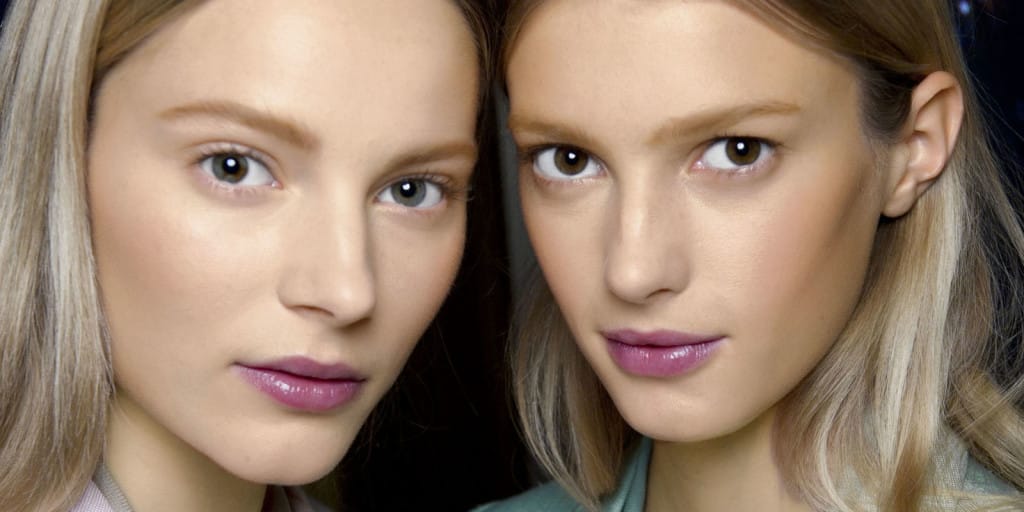
Skin Care:
1) Two rules are universal among experts:Use a retinoid nightly (the vitamin A derivatives stimulate collagen, fight wrinkles, and halt acne), and wear sunscreen daily. “The only time you don’t need sunscreen is when you need a flashlight to see,” insists Beverly Hills dermatologist Harold Lancer.
2) Sunblock every morning is critical, and dermatologist Elizabeth Hale says some of the best are in the drugstore aisles. “Look for one with zinc oxide for broad-spectrum sun protection and an SPF of at least 30.”
3) According to dermatologist Dr. Patricia Wexler, as soon as you start noticing dark spots from sun damage, which tend to show up in your 20s, it’s time for a retinol with vitamin C. “The combination of vitamin A and C will tackle wrinkles and lines, lackluster skin, enlarged pores and pigmentation very effectively,” says Wexler, who adds that you don’t have to wait for wrinkles to develop to start a retinol regimen.
4) Dendy Engelman advocates for a sonic cleansing brush. “It removes dead skin cells and clears the way for better penetration of your products.”
5) To rehydrate the skin and replenish those spaces between the cells, you need a combination of lipids, says Hale. Nourishing your skin via dietary sources such as salmon and other fatty fish is important, but you really need products with moisturizing ingredients like ceramides, shea butter, and fatty-acid-rich botanical oils, plus potent humectants like hyaluronic acid, which can hold 1,000 times its weight in water.
6) “[In your 50s] Follow your instinct to upgrade to richer products,” says New York dermatologist Joshua Zeichner, “and consider layering multiple hydrators,” from lightest to heaviest.
7) “The newest products contain ingredients that treat existing spots while also halting tyrosinase, an enzyme that controls melanin production,” says cosmetic chemist Ni’kita Wilson. She suggests products with vitamin C for brightening, arbutin and peptides to inhibit tyrosinase, and proxy acid to break up existing melanin.
8) According to Dr. Goesel Anson, Plastic Surgeon and Creator of JuveRest, “sleep wrinkles are the lines that are formed when the face is compressed against a pillow night after night and they occur in predictable locations based on fixed anchor points that hold the skin to bone.”The key to preventing them is sleeping on your back, which also has other beauty benefits, like clearer, firmer skin and better back alignment. “They can be treated with wrinkle creams and fillers such as Juvederm and Restylane, but they will likely come back or develop in adjacent areas if you don’t address the real problem, which is facial compression.”
9) Copper definitely plays an important role in maintaining healthy skin,” says dermatologist Joshua Zeichner, director of cosmetic and clinical research at Mount Sinai’s Department of Dermatology in New York. “It helps to develop collagen and elastic, which maintain the strength of the skin, and it promotes the production of skin-plumping hyaluronic acid.” (Translation: less sagging and fewer lines.) “It also has antibacterial and anti-fungal properties, which help prevent infections,” he adds, which is why it has been used in wound care since the 60s (and shows high hopes for acne treatment too).
10) Update your skin-care arsenal with products containing the antioxidant resveratrol. “In theory, it will help your skin over time because it prevents the breakdown of collagen and elastin,” says Fredric Brandt, a New York and miami dermatologist, and in turn firms loose skin under the chin and neck.
11) To even out skin tone and brighten a dull texture, look for products with vitamin C, the holy grail for fading brown spots.
12) To tighten slack neck skin, “look for products containing peptides, which can stimulate collagen and elastin synthesis,” suggests dermatologist Rachel Nazarian. Another ingredient you want: hyaluronic acid, which boosts moisture and plumps lines.
13) Stock up on moisturizer and hydrating masks: “Long-term dryness can lead to premature aging,” says celebrity facialist Joanna Vargas.
14) “To help with under eye bags, cut down on salt, increase water intake and look at whether certain foods—including wheat, dairy and alcohol—may be causing inflammation,” says acupuncturist Shellie Goldstein.
15) Did you know that the shadows under your eyes can be more aging than lines and wrinkles? Consider creams and serums that contain brightening extracts like licorice and algae.
16) According to Dr. Heidi Waldorf, the director of laser and cosmetic dermatology at The Mount Sinai Hospital, “Anything that blocks the return of blood flow from legs to the heart will put pressure on veins. Veins are soft structures without the thick muscular walls of arteries and pressure causes them to stretch and expand as the blood backs up and, ultimately, can speed the development of spider and varicose veins. Family history and having risk factors like large pregnancies plays a big role, too, so not everyone who crosses their legs regularly will get varicose veins, but if your parents have them, try to avoid crossing!”
17) The one ingredient everyone can benefit from? Hyaluronic acid, a time-tested moisture binder that smooths wrinkles.
18) Your cheat sheet to layering your skin care: After cleansing, apply eye cream (then avoid the area—layering products can irritate the area’s delicate skin), followed by serums (you can layer a couple on top of each to target different skin concerns, but give them each a minute or so to absorb), then moisturizers or light creams, then—for an extra boost of radiance and hydration—oils (some oils feel as light as serums, but their makeup doesn’t allow moisturizers to penetrate through them to the skin). The last step in your routine depends on the time of day: In the morning, finish with sunscreen. In the evening, finish with a retinoid.
19) “Anything that stimulates collagen production and evens out your skin is going to help it reflect light,” says Dr. Brandt, and the more light, the brighter your glow. Dermatologists suggest retinol or licorice extract to help illuminate skin, and glycolic, lactic, or alphahydroxy acids in at-home peels and microdermabrasion products to slough off dead skin cells “and thicken your collagen layer,” says Brandt.
Makeup:
20) “Skin tends to get drier as we get older, causing foundation to cluster in creases,” explains Gina Brooke, Madonna’s go-to makeup guru. To prevent foundation from morphing into a road map of your fine lines, start with moisturizer or face oil and follow with primer to create a smooth palette.
21) Reach for the highlighter. “A sheen can make skin look more taut,” makeup artist Pati Dubroff says.
22) To even out bumpy texture, makeup artist Pati Dubroff always starts with a primer. “It also helps makeup stay put on oily skin,” she says.
23) Skin color often change as we age, so be sure that your foundation matches your current skin tone. (To find the right shade, take a hand mirror and stand by a window to check it in natural light. Be prepared to be shocked.)
24) “Sun spots also confuse many women,” says Sandy Linter, a Lancome celebrity makeup artist. “Look for a shade in between the spots and the rest of your skin.” Even if you’re spot-free, warmer tones cane make you look younger. Finally, don’t use powder; it will amplify fine lines. If you’re truly oily, just powder your T-zone.
25) To make thinning lips appear plumper, start with a gentle exfoliation (a bit of brown sugar will work), then use a primer to keep lipstick from bleeding.
26) “If you were very dramatic with eye makeup when young, you have to tone it down a notch,” says makeup artist Angela Levin. “Harsh colors accentuate age.” Instead, look for more neutral hues; two complementary shadows are all you need.
27) “If you keep your eye open when applying shadow, you can go higher in the eye crease with your contouring color and that will open and lift the eye,” says New York makeup artist Kimara Ahnert.
28) Powder is a no-no when it comes to blush. “The key to looking fresh is using a cream blush—it’s more blendable,” Brooke says. Warm shades with a hint of pink or rose gold in them work best for most skin tones. “To give your face a lift, put blush on the apples of your cheeks, then add a touch of highlighter on the center of the cheekbones and blend it up to the temples.”
29) Don’t forget a brow pencil and a thin mascara wand; they’ll give you an instant eye life. A small comb allows you to thoroughly coat lashes from root to tip, and “filling in your brows wipes 10 years off your face,” says Anastasia Soare, Jennifer Lopez’s brow guru and founder of Anastasia Beverly Hills.
30) More mature lips should stay away from dark hues. “They make you look more severe and emphasize the small shape,” warns makeup artist Kimara Ahnert.
Hair:
31) Volumizing sprays are great, but to get truly thicker hair, you need to go for the gold standard of growth: minoxidil. First introduced by Rogaine, this FDA-approved topical (ideal for hereditary hair loss) is now popping up in your favorite product lines. Kérastase is the latest to offer a standard 2 percent formulation.
32) If you’re heat styling your hair several times a week, it’s vital that you replace lost moisture with a good hair mask or deep conditioner at least weekly.
33) Stop drying your hair with a cotton towel. “It’s the worst thing you can do,” says celebrity hairstylist Mark Townsend. The reason? Cotton fibers and loops get caught on hair, ripping open the cuticles and exacerbating frizz. Use a microfiber fabric instead, which provides a smooth surface to absorb water quickly.
34) “[The 30s] is the time when I start to hear my clients say, ‘My hair isn’t quite how it used to be,'” says Ted Gibson, Angelina Jolie’s longtime stylist. The biggest complaints: thinning and gray tresses. A daily supplement like Viviscal or biotin is “fantastic for growing hair,” he adds.
35) If gray regrowth at your roots is a monthly nuisance, beware of going too dark; it can lead to what the pros call “show polish-y” color. “When a single process gets too deep at the roots, every wrinkle, blemish, and spot on your skin will stand out,” colorist Sharon Dorram notes. Instead, ask your colorist for “sandy highlights strategically placed around your face” to cut the inkiness of a brown base.
36) Boost radiance once a week with a coconut oil treatment, advises Lorri Goddard. Apply to dry hair from roots to tips, and let it sit for 30 minutes. Before rinsing, lather up your shampoo, then add a small amount of water. “That breaks down the oil without stripping the moisture from your hair,” she says. Not an oil fan? Try a vinegar rinse instead.
37) Don’t make the common mistake of going totally blonde. “It washes you out,” says Dorram, who colors 60-year-old Christie Brinkley’s locks. The trick is to maintain your natural base color (whether dark blonde or medium brown) to add depth, which gives your overall tone a younger appearance.
38) “A flat iron is not something to scrimp on,” notes Townsend. Here’s why: Inexpensive plates often don’t heat up evenly, which means that they smooth your hair in some places but neglect others. As a result, you’re forced to run the iron over the same section again and again, ultimately frying and breaking your hair. To avoid this, look for irons that boast single pass capabilities (plates that heat uniformly so you can smooth an entire section of hair in just one swipe).
In-Office Treatments & Procedures:
39) “I always prefer to try peels before trying lasers,” advises Dr. Harold Lancer. “It’s less downtime- two or three days, versus five to seven- for someone who is busy. You don’t need the hardcore stuff yet.”
40) “My rule of thumb for Botox is, if you can see the lines when you’re not making the expression, it’s time,” proposes Dendy Engleman. “Most commonly we treat the eyes first because it’s the thinnest skin and the most prone to wrinkling.”
41) According to dermatologist Patricia Wexler, “If you start noninvasive treatments early, you may not need a face-life. My approach is three-dimensional. First, it’s about targeting muscles- the foundation of the face- with an Ultherapy ultrasound treatment [$4,500], which tightens both muscles and skin by stimulating the production of collagen. For extreme sagging on the neck or jowls, I’d reach for ThermiRF, a radio-frequency device [$6,500]. A tiny needle goes inside the skin to melt fat and tighten. Next, it’s about adding volume. I like to inject Restylane, a filler, under the muscle instead of directly in folds, for a nice plump life – along the jawline, the front of the ears, and the apples of the cheeks. Finally, I’ll resurface with a Fraxel Dual laser [$2,000]. It makes microscopic tunnels in the skin to create new collagen. If you have done it enough times, all of your old skin is replaced.”
42) When a clog forms, that’s when pores become distended. If they remain clogged, the surrounding collagen and elastin fibers can overstretch permanently. If the clog is removed quickly, pores can ‘shrink’ back to their original size. Most cleansers, scrubs, and even microdermabrasion can’t get deep into pores. It requires synergy between multiple chemical exfoliators that dissolve both solids (dead skin cells) and liquids (oil), like my glycolic acid, tea tree oil, and pumpkin-seed-extract-based BeautyRx Dermstick for Pores [$29], which clears up pores overnight.
43) The other cause of enlarged pores is the destruction of collagen and elastin from sun damage. I recommend biweekly glycolic acid peels [$225], and, if needed, Fraxel [$900], which boost collagen and tighten stretched pores,” says Shani Darden, a Los Angeles facialist.
44) Powerful laser beams can improve the appearance of fine lines, sun damage, laxity and acne scars with little or no risk of scarring, and minimal downtime. “There has been a huge boom in lasers, particularly Fraxel,” says New York dermatologist Elizabeth Hale. “Even women who don’t want injectables are asking for it because you can rejuvenate the whole face without a drastic change in appearance.”
45) “The best way to get rid of sun spots is with lasers,” says dermatologist Robert Anolik, who uses a rapid-pulse Q-switched ruby laser to treat individual spots. The procedure requires no anesthesia, and typically a scab will form on the treated area and fall off in about a week.
46) The most popular treatment for creating natural but lush lips is injecting fillers, which add back lost (or never quite God-given) volume, as if restuffing a pillow. Both Chapas and Brandt favor hyaluronic acid gels (such as Restylane, Juvederm, and Belotero) over substances like collagen, which tends to disappear within a few weeks. Hyaluronic acid, on the other hand, sticks around for up to 12 months. Another reason it’s a volume VIP, says Beverly Hills dermatologist Harold Lancer, is that it’s unlikely to cause an allergic reaction, and in the event that you don’t like the resule, there’s an antidote that can dissolve the filler.
47) Ask your dermatologist about Belotero, a hyaluronic acid facial filler designed to treat the finest of lines. “It’s one of the best options because it creates the most natural results,” says dermatologist Bruce Katz, director of the Juva Skin & Laser center in New York. The technique is to “very superficially inject with the thinnest needle possible,” he explains. When it’s done properly, patients can look “up to 10 years younger.”
48) If the horizontal lines on your neck are deeply etched, fillers can provide instant gratification, says Dr. Heidi Waldorf, the director of laser and cosmetic dermatology at The Mount Sinai Hospital, who favors hyaluronic acid–based options like Belotero or Restylane Silk (about $750–$3,000). Another quick but effective fix: Botox (around $750). It can help relax the vertical (platysma) muscle, which gives the neck a ropy look, says Waldorf.
49) Restylane Silk is a new lip filler that’s creating major buzz. “It has smaller particles than other fillers, and it integrates seamlessly without forming bumps,” says Arielle Kauvar, a dermatologist in New York. “We can create contour within minutes by injecting filler along the border of the lip. You are not enlarging them as much as restoring them. Lipstick will no longer bleed into lines.”
50) Try a micro-needling facial. “These channels allow a momentary increase in permeability that is hundreds of times the normal degree that topical products can penetrate the skin,” says Jon Turk, a New York plastic surgeon. “Depending on the desired target—pigment, thin skin, wrinkles—the appropriate topical serum effect can be accelerated dramatically.”
Image: Getty
Via: Harper’sBazaar.com



